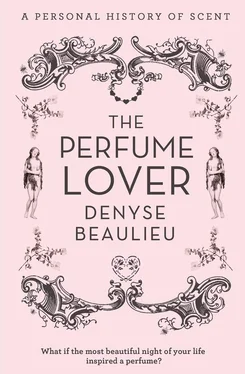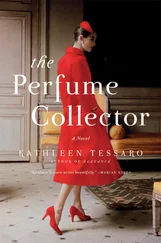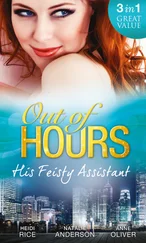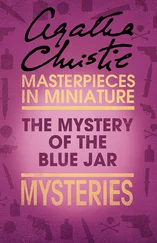So ‘plague doctors’ stuffed them in beak-shaped masks as they made their rounds during epidemics of the Black Death; aromatic materials were burned in houses, churches, streets and hospitals. And if the wealthy lavishly scented their clothes and held pomanders to their noses, it wasn’t only to cover up the effluvia of the great unwashed or the stench of cities and palaces: scent was their invisible armour against the Reaper. In fact, if everyone from kings to paupers did give off quite a pungent aroma from the late 15th century, when public baths were shut down for moral reasons (they often harboured prostitutes), until the late 18th century, it was precisely because foul miasmas were believed to carry disease. Physicians were convinced that water distended the fibres of the body, leaving it wide open to airborne contamination. Therefore, bathing was undertaken only under strict medical supervision, and people who’d just bathed were advised to stay under wraps for hours, if not days, until their bodies had sufficiently recovered to withstand exposure. Such cleanliness as there was came from washing face, teeth and hands with various cosmetic preparations; bodily grime was meant to be absorbed by white linen shirts, which only the upper classes could afford to change daily.
But the very notion that perfume had curative or protective properties implied that it could have the reverse effect, at least potentially. In Ancient Greece, the word pharmakon, from which ‘pharmacy’ is derived, designated both the poison and the remedy. If aromatic essences could act on the body by penetrating through the nose or skin, they might also kill. Odours are invisible: unlike poisonous foods which you can choose not to eat if you suspect something is amiss, you can’t defend yourself against them – you can’t hold your breath forever. And strong, apparently pleasant fragrances could very well conceal subtle poisons.
In the midst of the religious war that tore France apart in the late 16th century, the Catholic Queen Catherine de’ Medici was thus suspected of having assassinated the Protestant Jeanne d’Albret, Queen of Navarre, with a pair of poisoned gloves made by her perfumer Renato the Florentine. Though unfounded (Queen Jeanne died of tuberculosis), the accusation gives an indication of the ambivalent properties attributed to perfume. Even natural fragrances were suspicious. In 1632, in a clear-cut case of collective hysteria, the nuns of a convent in Loudun accused the priest Urbain Grandier of having cast a spell on them: the first to be ‘possessed’ by the charismatic Grandier claimed she had been bewitched by the smell of a bouquet of musk roses. Grandier was burned at the stake for witchcraft.
By the middle of the 18th century, some of the very aromatic materials that had been considered both exquisite and prophylactic were being condemned. Substances of animal origin such as musk, civet and ambergris were lumped in with putrid matters through medical anathema. The smell of musk, for instance, was compared to that of manure or fermented human excrement. Its very strength unsettled ‘our more delicate nerves’, wrote Diderot and d’Alembert in their Encyclopaedia in 1765. As the upper classes renewed their acquaintance with water and came to enjoy light, vegetal scents such as the eau de Cologne, wearing heady animalic concoctions became the sign not only of doubtful hygiene but of depraved tastes, fit only for skanky old libertines and their whores.
Perfume would remain a remedy until 1810, when Napoleon decreed separate statuses for perfumers and pharmacists: since the latter were compelled to disclose the composition of their preparations, the former chose to relinquish any medicinal claims to preserve their trade secrets. But perfumers never completely shook off the ambivalence of the original pharmakon … No wonder a perfume-phobic pharmacologist’s daughter ended up sticking her nose in it.
If I wanted further proof that perfume is indeed toxic, I’d filch my dad’s old lab coat to analyse the 1999 Hypnotic Poison, whose red bottle contains the antidote to the green one I was given over twenty years ago: Snow White’s poisoned apple, ripe and fit at last for a grown woman.
Was the perfumer Annick Menardo aware of what she was doing when she stuck an almond note into its jasmine sambac, musk and vanilla accords? As any reader of classic English murder mysteries knows, you can tell whether a victim has been poisoned with cyanide from the lingering smell of bitter almonds. In fact, like apple seeds or peach and cherry pits, the bitter almond contains a highly poisonous substance, amygdalin, which in turn contains sugar and benzaldehyde, a common aromatic ingredient that smells like amaretto liqueur, but can also yield cyanide. And thus, Hypnotic literally reeks of poison disguised as a delicacy, its toxicity betrayed by the slight bitterness of caraway seeds rising from a powdery cloud …
I’d long wanted to ask Menardo about that almond note, and lay my love at her feet for what must surely be one of the weirdest scents to come out in a mainstream brand, Bulgari Black. When I wear Black, I feel that I’ve either a) dropped my liquorice macaroon in my cup of lapsang souchong, b) powdered my butt with fancy talcum and slipped on my rubber bondage skirt, c) crossed a tough neighbourhood where someone’s been burning tyres in a cab that’s got one of those little vanilla-scented trees dangling from the rear-view mirror, or d) been guzzling the world’s peatiest single malt whisky and gargled with Shalimar to hide the fact.
But getting in touch with the brilliantly gifted Menardo was a daunting task. Perfumers working for big companies are much less accessible than independents like Bertrand Duchaufour. You can’t just cold-call them – least of all Menardo, who is famously reticent and uncompromising. Every time I brought her name up, insiders would wish me luck. And I did get lucky: while visiting the offices of Firmenich, where she works, I bumped into her in a corridor, a tiny bristling dark-haired sprite in a hot-pink top. It seemed awkward to spring my question about almonds – how pleasant can it be to be waylaid by some strange woman on your way to a meeting or to the loo? So after gushing about Bulgari Black (she gruffly responded, ‘But that’s old stuff!’), I let her go, contacted her again through email, and we made a phone appointment so that I could ask her about Hypnotic Poison.
So: did she work in the almond note on purpose? She chuckles.
‘I didn’t psychoanalyse myself. It’s possible.’
She explains she worked on the idea of toxicity by playing on the strength of the smell: ‘I knew I had to do something that was meaner than Poison.’
I point out to Annick that the apple seems to be a leitmotif in her career: another one of her best-sellers, the anise and violet Lolita Lempicka, which came out the same year as Hypnotic Poison, is also packaged in an apple-shaped bottle. She answers that apple itself is one of her fetish notes – a fond memory of a shampoo she used as a teenager, Prairial – so she sticks it in wherever she can. By this time we’re chatting away quite happily, and I confide the story of Geneviève’s poisoned parting gift.
‘Green Apple? Hey, I wore that too when I was a kid!’
My phone almost drops from my hand. The formidable little witch who whipped up my antidote to Green Apple actually wore it herself. There are no coincidences with perfume: it’s all black magic.
Despite my admiration for the cavity-inducing Hypnotic Poison, olfactory pastries were never something I could get particularly worked up about. I may want to offer myself up at dessert when the mood strikes; I don’t want to smell of it. Which is why Bertrand Duchaufour’s take on vanilla delights me particularly: it reminds me of something I’d much rather wrap my lips around after dinner than a spoonful of vanilla ice cream … a good cigar.
Читать дальше












